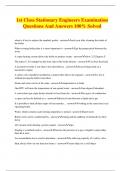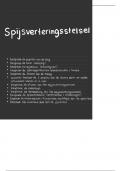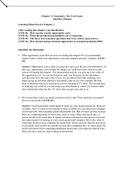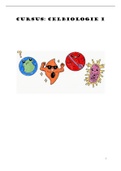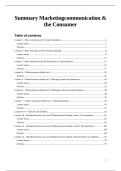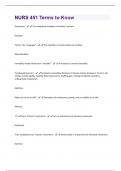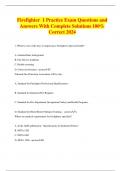Table of contents
Readings week 1 ........................................................................................................................ 2
Lecture 1 – Introduction & How marcoms work I: Explicit attitudes..................................... 2
Lecture 2 – How marcoms work II: Implicit attitudes .......................................................... 12
Lectures week 1 ....................................................................................................................... 15
Lecture 1: Introduction & How marcoms work I: Explicit attitudes .................................... 15
Lecture 2: How marcoms work II: Implicit attitudes ........................................................... 23
Readings week 2 ...................................................................................................................... 29
Lecture 3 – How marcoms work III: Persuasion vs. brand salience ..................................... 29
Lecture 4 – Guest lecture MediaBrands: Marketing strategy.............................................. 37
Lectures week 2 ....................................................................................................................... 38
Lecture 3 – How marcoms work III: Persuasion vs. brand salience ..................................... 38
Readings week 3 ...................................................................................................................... 42
Lecture 5 – What marcoms should say I: Message content for persuasion ........................ 42
Lecture 6 – What marcoms should say II: Message content for brand salience ................. 49
Lectures week 3 ....................................................................................................................... 60
Lecture 6: Brand salience .................................................................................................... 60
Readings week 4 ...................................................................................................................... 69
Lecture 7 – Where marcoms should say it I: Media planning ............................................. 69
Lectures week 4 ....................................................................................................................... 73
Lecture 7: Where marcoms should say it I: Media planning ............................................... 73
Readings week 5 ...................................................................................................................... 75
Lecture 10 – Should marcoms say it at all? Marcoms and climate crisis I: The consumer .. 75
Lectures week 5 ....................................................................................................................... 79
Lecture 10: Should marcoms say it at all? Marcoms and climate crisis I: The consumer .... 79
Readings week 6 ...................................................................................................................... 79
Lecture 11 – Should marcoms say it at all? Marcoms and climate crisis II: The advertiser . 79
Lecture 12 – Should marcoms say it at all? Marcoms and climate crisis III: Focus on
solutions .............................................................................................................................. 86
Lectures week 6 ....................................................................................................................... 89
Lecture 11: Should marcoms say it at all? ........................................................................... 89
Lecture 12: Should marcoms say it at all? Marcoms and climate crisis III: Focus on
solutions .............................................................................................................................. 89
1
, Readings week 1
Lecture 1 – Introduction & How marcoms work I: Explicit attitudes
De Pelsmacker, P., Geuens, M., & Van Den Bergh, J. (2013, Chapter 3). How marketing
communications work. In P. De Pelsmacker, M. Geuens, & J. Van Den Bergh (Eds.),
Marketing communications: A European perspective (5th ed., pp. 72-119). Harlow:
Pearson.
Factors to predict how a consumer will respond to advertising or how someone will process
a communication message:
1. Consumer goals
2. Characteristics of the product type
3. The situation the consumer is in (hurried or distracted by others for example)
4. Involvement in the product category
5. Social, psychological or cultural factors
Hierarchy-of-effects models are some of the oldest marketing communication (MC) models.
It assumes that things have to happen in a certain order, implying that the earlier effects
form necessary conditions in order for the later effects to occur. It states that consumers go
through three different stages in responding to MC:
1. Cognitive: consumers engage in mental thinking processes which leads to awareness
and knowledge of the brand.
2. Affective: emotional or feeling responses occur associated with the advertised brand
and attitudes towards the brand are formed. May only be formed when the need for
evaluation arises.
3. Conative / behavioral stage: undertaking actions with respect to the advertised
brand, such as buying it.
è A think-feel-do sequence
However, a lot of disagreement exists regarding the sequence of the different stages, and
several researchers have developed alternative models. An example is the low-involvement
hierarchy-of-effects model according to which consumers, after frequent exposure to
marketing messages, might buy the product, and decide afterwards how they feel about it
(cognitive– conative–affective hierarchy). Another possibility is the experiential hierarchy-of-
effects model in which consumers’ affective responses towards a product lead them to buy
it and, if necessary, they reflect on it later. This would suggest an affective–conative–
cognitive sequence.
Vaughn proposed an integration of the different sequence models and presented a model:
the Foot–Cone–Belding (FCB) grid. Four different situations are distinguished, based on two
dimensions:
1. The high–low involvement: Involvement can be defined as the importance people
attach to a product or a buying decision, the extent to which one has to think it over
and the level of perceived risk associated with an inadequate brand choice.
2. Think–feel dimension: represents a continuum reflecting the extent to which a
decision is made on a cognitive or an affective basis. Here Vaughn takes into account
that for certain products, such as sugar, mineral water, paper towels, soap and
2
, banks, cognitive elements are important, while for products such as cakes, ice cream
and perfume, affective elements seem to have more impact on the buying decision
process. For example, consumers may wonder whether they are running out of
water, or whether they will need paper towels during the next week. This is in
contrast to considerations such as what to buy the children for a treat: Kinder Delight
or chocolate mousse?
FCB grid explained per quadrant:
1. Purchase decisions are characterized by high involvement and rational decision
criteria -> the consumer wants to learn about the product. E.g. insurance policy or a
loan
2. Concerns product decisions of high involvement for which less information is needed.
The consumer first wants to be emotionally attracted by the brand image, then
collects information, and finally undertakes some action. Jewelry, perfume, fashion
and holidays.
3. Product decisions are located that require a minimum of cognitive effort and tend to
become routinised because of habit formation. Buying, learning, developing an
attitude. Toilet paper, sugar, paper tissue.
4. Decision making regarding products which can be seen as life’s little pleasures. Buy,
experience an effective response, gather knowledge afterwards.
The Rossiter–Percy grid is an alternative to, or a modification of, the FCB grid which again
classifies products and buying decisions in four categories, based on the dimensions of high–
low involvement and fulfilling a transformational or informational buying motive.
1. Transformational buying motives consist of positive motivations, such as sensory
gratification, social approval or intellectual stimulation. E.g. products that give
consumers pleasure, such as ice cream, cosmetics and perfume.
2. Informational buying motives refer to reducing or reversing negative motivations
such as solving or avoiding a problem, or normal depletion. E.g. detergents, babies’
nappies and insurance products.
Most companies strive to reach Top-of-mind awareness (TOMA) in consumers. TOMA
indicates which brand is most salient within a product category. It reflects the first brand
that comes to mind when thinking of a particular product category. It is generally
acknowledged that brands that are top of mind are more likely to be purchased.
3
, Attitude formation and change
Attitude: a person’s overall evaluation of an object, product, person, organization, ad e.g.
Can be considered a measure to what extent a person (dis)likes a brand. Attitudes can
change over time, so companies want people’s attitude to change in favor of their brand.
Consists of three components:
1. Cognitive: knowledge, beliefs and evaluations of the object
2. Affective component: the feelings
3. Behavioral: action readiness
The different communication models can be classified along two dimensions:
1. The way attitudes are formed – primarily cognitive, affective and behavioral
2. Level of elaboration of a message
è The involvement dimension of the FCB grid is extended to motivation, ability and
opportunity (MAO). By motivation, a willingness to engage in behavior, make
decisions, pay attention, process information, etc., is meant. Motivation is to a large
extent influenced by consumer needs and goals. Consumer needs can be categorized
as:
1. Functional: informational motivation dimension of the Rossiter-Percy grid
2. Symbolic: how we see ourselves and how we would like to be perceived by others
3. Hedonic: reflect consumers’ desires for sensory pleasure
è Needs/goals can also be classified as approach or promotion goals, and avoidance or
prevention goals.
In order to be persuasive, marketing communications should tap into consumers’
motivational concepts and marketers need to understand what goals consumers are trying
to accomplish by buying the product.
Ability refers to the resources needed to achieve a particular goal.
Opportunity deals with the extent to which the situation enables a person to obtain the goal
set.
The effects of the MAO factors on attitude formation and marketing communications
processing are presented in the Elaboration Likelihood model (ELM). If motivation, ability
and opportunity are all high, the elaboration likelihood is said to be high and consumers are
expected to engage in central-route processing. This means that they are willing to elaborate
on the information, to evaluate the arguments and find out what the information really has
to offer.
4

